How to Set Goals
Goal setting is one of my favorite things to do with clients, and it’s a tool that absolutely everyone can benefit from. This time of year especially, I notice many (myself included!) reflecting and setting goals and resolutions for the year to come. And that’s great! The key is to learn how to set goals that are actionable, instead of fantasizing about dreams like you’re wishing upon a star and stopping there. I want to empower you to achieve your goals through strategy, SMART goals, a positive mindset, and being real about the hard work required to make your goals happen.

Goal Setting Definition
According to Merriam-Webster dictionary, the definition of a goal is “the end toward which effort is directed,” (1).
According to Your Dictionary, the goal setting definition is, “the process of identifying something that you want to accomplish and establishing measurable goals and timeframes,” (2).
Think of a goal as the destination you’re entering into your GPS. It’s a specific endpoint that can help guide you to your destination – but you still need to put in the time and effort to get there.
Dreams vs Goals
Dreams are absolutely related to goals. In fact, they’re often defined as strongly desired goals (3). But the biggest difference between dreams vs goals is that dreams often aren’t as tangible and specific as goals. Dreams can help guide your goals, but ultimately a goal is more strategic and can better focus and guide your daily actions.
Benefits of Goal Setting
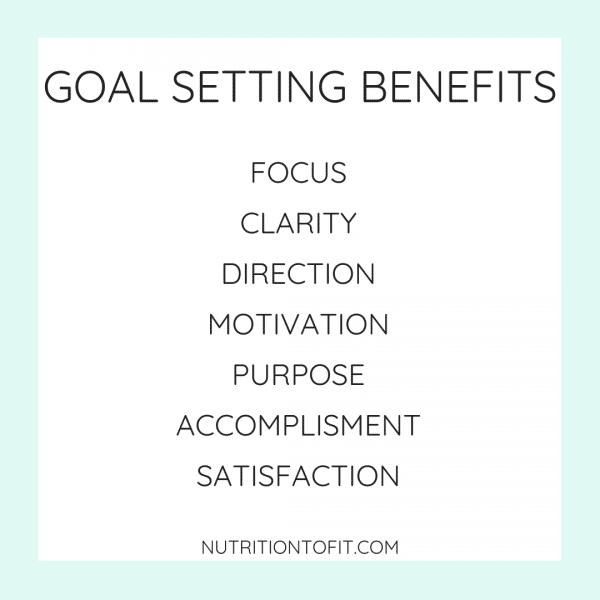
The fact that goals are tangible, planned, and strategic is one of the biggest benefits of goal setting. They can help serve as a barometer of your daily life, making sure that where you’re investing your time and resources correlates to your goals and priorities.
Goal setting benefits you by providing more focus, purpose, motivation, and accomplishment and satisfaction when a goal is accomplished.
How to Set Goals
When you’re learning how to set goals and trying to figure out what your goals are, SMART goals are a fantastic way to frame your goals. What’s a SMART goal? A SMART goal is an acronym for a goal that is:
- Specific
- Measurable
- Attainable
- Relevant
- Time-Bound
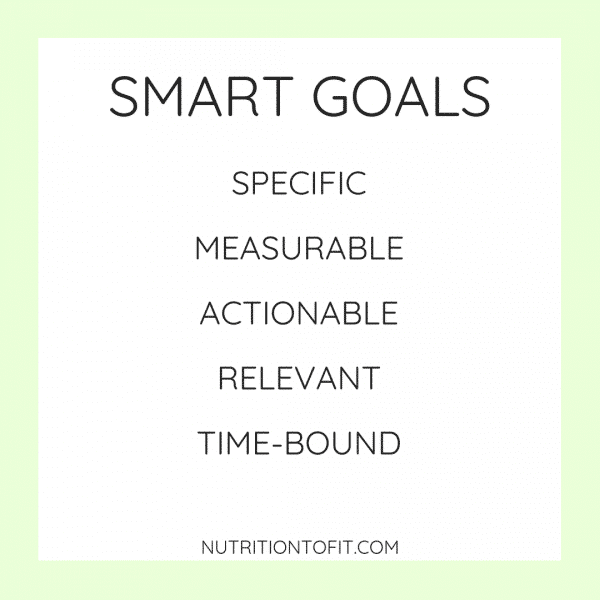
Set Specific Goals
A specific goal is one that is well-defined and can help you focus with a clear direction. It can help to use action verbs when getting more specific with your goal.
For example, instead of saying, “I want to get more active,” a more specific goal may be, “I take the stairs at work everyday.”
Set Measurable Goals
A measurable goal is just that – a goal that is written in a way that can help you measure your success.
For example, saying you want to cook more is great, but a more measurable goal is to cook one new recipe at home every week.
Set Attainable Goals
Your goals should challenge you but should also be attainable. Goals need to be something you can realistically achieve in a foreseeable future.
Maybe you’ve always wanted to run a race but you’ve never run before. “I want to run a marathon,” likely won’t be the most realistic goal for you. A more attainable goal would be, “I will train for my first race – the Super Awesome 5k in 3 months.”
Set Relevant Goals
Your goals have to be relevant to your life priorities. What is most important to you right now? Where do you want to spend the majority of your time and efforts? Relevant goals feel more valuable, and knowing this value will help keep you motivated in the moments of hard work and effort that don’t feel as exciting and fantastic as your end goal.
If your current priorities are raising a family and living a healthier lifestyle, your goals should align with those areas. A not-so-relevant goal for this time of your life may be going back to school for your master’s degree.
Set Time-Bound Goals
One of the best ways to set an achievable goal is to create a sense of urgency. Enter: time-bound goals. Giving yourself an attainable deadline can also help you break your main goal down into smaller, more frequent action items – like the daily and weekly plans of a training program to run a marathon.
How to Achieve a Goal Successfully
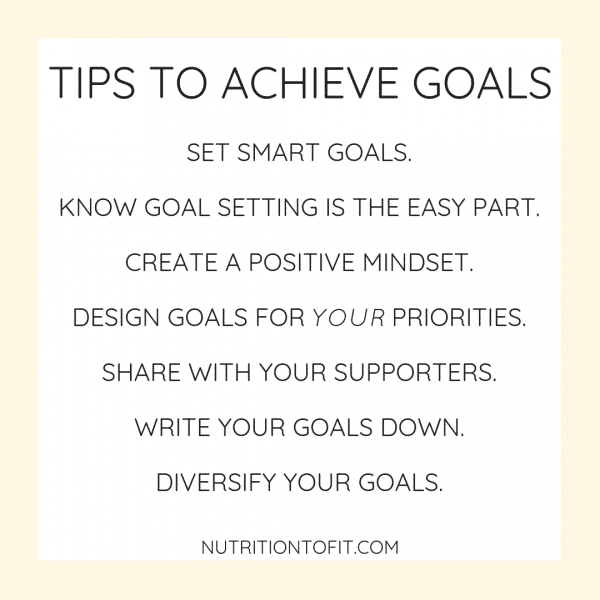
Once you’ve been strategically thinking about your life priorities and setting correlating SMART goals, there are a few more tips for achieving your goals:
- Understand that setting a goal is just the beginning. This is the easy part. The hard part is turning your goal into smaller action items and systems and actually doing the work.
- Create a positive mindset. Hard work is required to achieve any goal and a positive mindset is one of the best tools you can have. Goals that are framed negatively aren’t motivating, so try a more positive framework. Instead of focusing on the negatives, like the motivation for your new running regimen being you not fitting an old dress you wanted to wear to your high school reunion, approach it more positively by focusing on creating a more active lifestyle that helps you better manage stress, get stronger, and feel more confident in your body.
- Design your goals for your priorities. Successful goals are relevant to your life priorities – which means sometimes you may need to go against what others want for you if it’s not aligned with what you want for yourself. Maybe your parents want you to go to law school, but your heart is in education. Maybe your spouse wants you to take up yoga with them, but you’re not into it. It’s hard to say no, but that’s okay. Your goals have to relate to what’s important to you and not anyone else. Be confident and have a conversation – it’s tough, but often our loved ones want what’s best for us however it looks.
- Share your goals with your people. The more support you have as you work toward your goals, the more likely you are to succeed. Bonus? Sometimes your support people may join you! Maybe they’ve been wanting and needing to tackle cutting back their grocery budget, too! Oh, and don’t forget the pros. Talk to your doctor before making major changes to meet your health goals. Work with other professionals for more support, like personal trainers, financial advisors, therapists, and (like myself!) registered dietitian nutritionists.
- Write down your goals. One of the best ways to achieve a goal is to write it down. You can write it as a note in your phone, in your journal, on top of your calendar or planner, or even as a sticky note on your computer or dashboard. Somewhere you’ll frequently see it and can be reminded the value of why you’re doing this!
- Diversify your goals. Make sure you’re setting goals in different areas of life, like career, education, health, relationships, social, finances, spiritual, and more. If all your goals and efforts are in one area, you’re going to burn out a lot faster. Setting goals in different areas (all relevant to your life priorities!) will give you more balance in your life and make your lifestyle more sustainable.
Why Goals Fail
The number one reason goals fail is because you’re not actually willing to do the hard work.
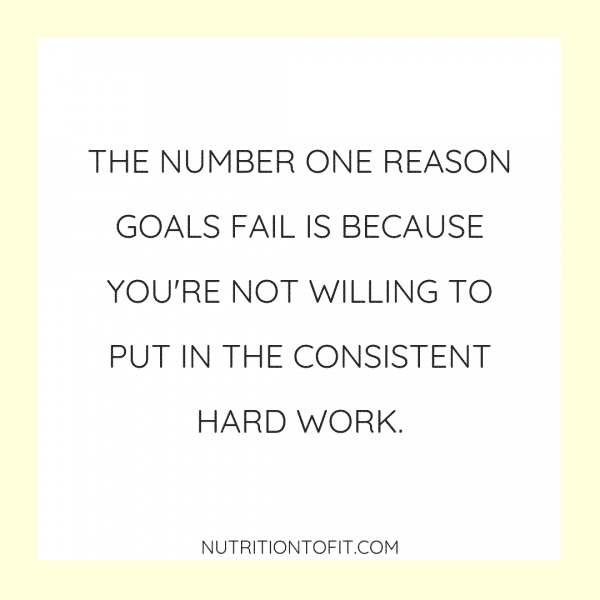
Goals can be fun and exciting. But think again of our GPS analogy: it does take effort to find the correct address and input it into your GPS, but that doesn’t mean you’re automatically there. You still have to do the work to reach your destination.
Goals work the same way. It’s important to set strategic goals that can help direct you, but you still have to do the work to get there. And just like with driving, there will beautiful, scenic drives and there will also be roadblocks, traffic, thunderstorms, and moments where you need to re-route. That’s totally okay and expected. Ready your mindset and be prepared for hard work, sacrifice, trade-offs, and reward!
Create an Action Plan and Systems
The best way to prepare to achieve your goals is to create an action plan and systems. Evaluate your current routines and see where you need to make adjustments. Then, create new systems accordingly.
One example? If you constantly find yourself skipping breakfast, prep some grab-and-go breakfast staples on the weekend, like hard-boiled eggs and baked oatmeal. Check out the goal setting examples below, where I’ve also included examples of systems and action plans that may need to be implemented.
Goal Setting Examples
Using the SMART goals model, here are some examples of smart goals:
- Goal: I lose 25 pounds in the next six months, losing on average 1 pound a week.
- Action Plan: Stock kitchen with a variety of healthy, whole foods, visit doctor for a physical, hire a dietitian to help understand how to create a balanced meal and eat for your health, learn how to cook some basic healthy staples at home, and create a positive mindset around food.
- Goal: Save $1,000 a month for the next five years for a house down payment.
- Action Plan: analyze your budget to make sure this number is realistic, adjust your budget and lifestyle if necessary, and mentally prepare for potential sacrifices and trade-offs, like taking the money from a weekend ski trip and putting it towards savings instead.
- Goal: Create a more positive mindset by dedicating 15 minutes to gratitude journaling every day for the next month.
- Action Plan: Set up a journaling system that works for you (i.e. paper and pen, buying a specific gratitude journal, or looking at a digital journey where you can record entries in an app or notes on your phone) and look at your schedule to see when is the best time for you to carve out these 15 minutes consistently.
- Goal: Run a local half marathon by October.
- Action Plan: Research half marathons to find one that fits your time frame, find a training plan that works for your schedule, have a physical to make sure you’re physically ready to start a training plan, and make sure your schedule and mindset in this season of life are ready for the time and mental constraints of a training program.
Grab Your FREE Goal Setting Worksheet!
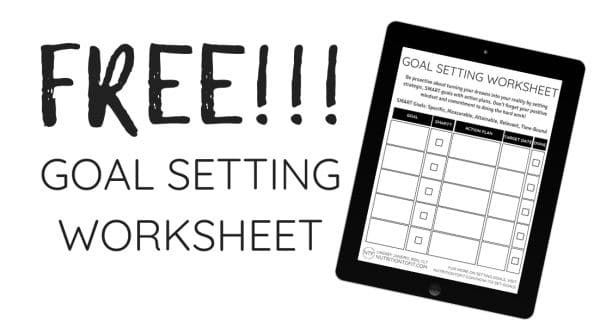
Ready to get strategic and set some SMART goals? Sign up below to go straight to your FREE Goal Setting Worksheet PDF!
[mailerlite_form form_id=4]






